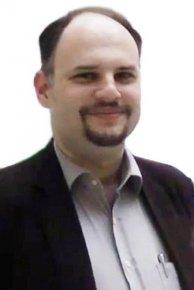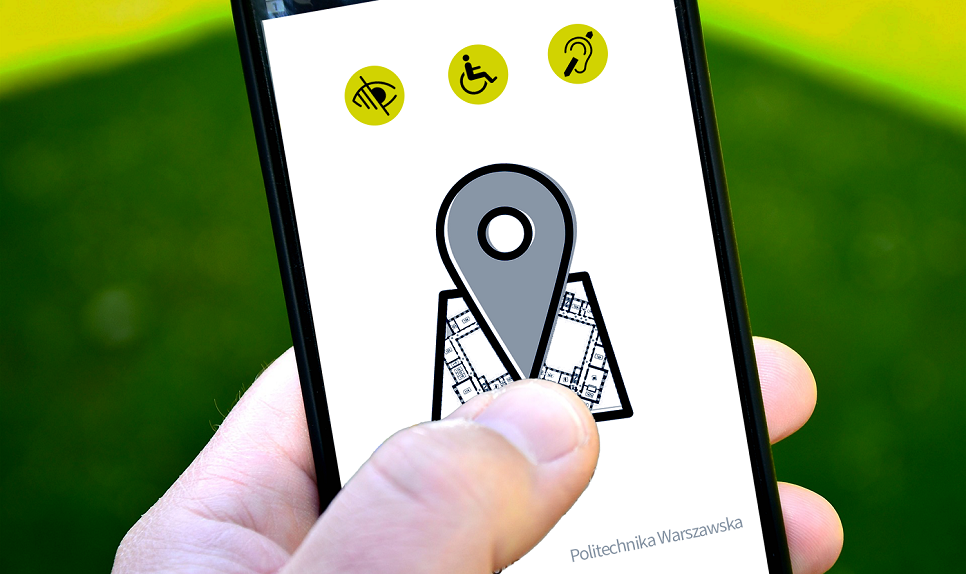The application will help you navigate around WUT
It's here! – perhaps such a message will be heard by the users of the application that will make it easier to navigate in the five buildings of the Warsaw University of Technology. Its concept was created by University employees, taking into account in particular the needs of people with disabilities.
The Main Building is an architectural gem, a place eagerly chosen as the backdrop for photo sessions – not only by graduates proudly holding their newly defended diploma thesis. The layout of the rooms, however, is so problematic that people visiting the building, especially for the first time, find it difficult to find their way around. This is to change via the application, the concept of which was proposed by Prof. Dominik Sierociuk from the Faculty of Electrical Engineering together with a team of employees from various units of the Warsaw University of Technology.
In search for solutions
– The project was born after successive rounds in the Main Building and the search for various rooms. I believe that many people have encountered it – says Prof. Dominik Sierociuk. – The idea became more concrete during the implementation of student projects as part of the Creative Design Semester, led by the Rector's Team for INFOX PW Innovative Forms of Education – he adds.
One of the topics our students dealt with was the issue of navigation in the Main Building. The second group was to find a way for blind people to operate an ATM or a snack or coffee machine.
– During the implementation of this student project that I supervised, we met some amazing people. Despite losing their eyesight, they wanted to remain active and independent – says Prof. Dominik Sierociuk. – It was a great lesson for us in the context of developing tools for people with disabilities. Close cooperation with them is needed, since what we find useful or helpful does not mean that it is really so for them. With this type of solutions, consultation with people with disabilities is crucial both at the concept and implementation stage – he emphasizes.
Prof. Sierociuk returned to the idea of the navigation system when the National Center for Research and Development announced the competition "Accessible University".
– It immediately dawned on me that such a system could be created thanks to the funds from the competition – he says. The preparation of the winning application "Warsaw University of Technology as the Innovation Ambassador for Accessibility", which also included a number of other activities, was coordinated by Prof. Przemysław Duda, Vice-Dean for General Affairs at the Faculty of Physics.
Interdisciplinary team
The existing concept had to be altered. A team was formed that defined the shape of the system and its functionality. Apart from Prof. Dominika Sierociuka from the Faculty of Electrical Engineering, the work was also attended by: Prof. Dariusz Gotlib and Jacek Marciniak, PhD Eng., from the Faculty of Geodesy and Cartography, Marcin Luckner, PhD Eng., from the Faculty of Mathematics and Information Sciences, Aleksandra Duszyńska from the Section for People with Disabilities and Joanna Kaczanowska from The Computing Center.
– When creating the concept of the system, we tried to consider it very broadly, from different angles – emphasizes Prof. Sierociuk.
The system is to include five buildings: the Main Building, the Electronics Building, the Physics Building, the Center for Innovation and Technology Transfer Management, and the research and teaching center in Józefosław, which, due to the CENAGIS project, the testing field for the indoor navigation application, will become a place for additional experiments.
The application will be the basis of the system. Its main task is to determine the user's position and show the way to the given waypoints. Additionally, all destinations will have a description. A selected person will be able to edit it.
The application will be available to students, employees and all people who want to visit any of the buildings, in particular people with various disabilities.
– While browsing the market solutions, we noticed that there are a lot of them, but they are aimed at one group, especially the blind. According to the principles of universal design, we want one solution for the widest possible group of people, i.e. an application that can be configured depending on the needs – explains Prof. Sierociuk.
The authors of the concept immediately assumed that the whole concept, and then the implementation of the system, would be based on close consultation with people with disabilities, so that the solution would be useful for them.
Application without restrictions
The application will be very useful for deaf people, for whom each asking for directions poses a big problem due to the small number of people using sign language. Thanks to it, they will be able to boldly find their way to the places they want to visit. On the other hand, messages that require longer reading will be presented in the form of a video with the participation of the person providing the information in sign language.
Bearing in mind people with motor disabilities, the concept of the system has also been extended to include the space between the buildings. – First you have to get into the building, which in the case of a wheelchair user who wants to enter the Main Building is not that easy. This can be done by using the external elevator in the north courtyard or from the driveway by the library. The system will indicate where the facilities are, and the best way to get to the building – explains Prof. Sierociuk.
– When it comes to navigating blind and visually impaired people, the problem we had to deal with was the last episode of getting a person to a certain place. The method we want to use are sound actuators. They will be placed in the most frequented or strategic points, e.g. at elevators, toilets or building entrances. When a blind person comes close to them, the actuator will send a short "it's here" signal – explains Prof. Sierociuk.
Availability not restricted to users only
– We want the application to have a programming interface (the so-called API - apllication programming interface), which we will be able to make available to both students and employees to conduct their own research or, for example, prepare diploma theses – says Prof. Sierociuk. - The system will contain a lot of information: building maps, navigation paths, PoI (Point of Interest) points, such as cloakrooms, toilets, food outlets, dean's offices, as well as their descriptions. Detailed interior maps will be obtained as part of another task in the same project – "Building Accessibility Maps", led by Prof. Dariusza Gotliba. The application and maps can be downloaded and used for their solutions, applications and testing. This also distinguishes our project from the solutions of less technical universities – he emphasizes.
The application is also to be in English, which will be a great help, for example, for foreign students or people coming to conferences. You will be able to use the tool without logging in.
– Besides, we assume a certain way of integration with the students' timetable, so that they can easily navigate between them – adds Prof. Sierociuk.
Indoor or maybe ‘indor’ (a male turkey - in Polish)?
People associated with the project have not yet thought about the name of the application to be created. – In the presentation during the inauguration of the Universal Design Center of the Warsaw University of Technology, I put a picture of a beautiful turkey, because at the very beginning in the description, due to an autocorrect mistake, a Polish male turkey appeared instead of the English word "indoor". I think this logo can remain – laughs Prof. Sierociuk.
Soon, the University will announce a tender for the construction and implementation of a navigation system. It is to start operating in mid-2023 at the latest.
The project "Warsaw University of Technology as the Innovation Ambassador for Accessibility" is co-financed by the European Union from the European Social Fund under the Knowledge Education Development Operational Program. The Innovation Management and Technology Transfer Center is its coordinator at the central level.










